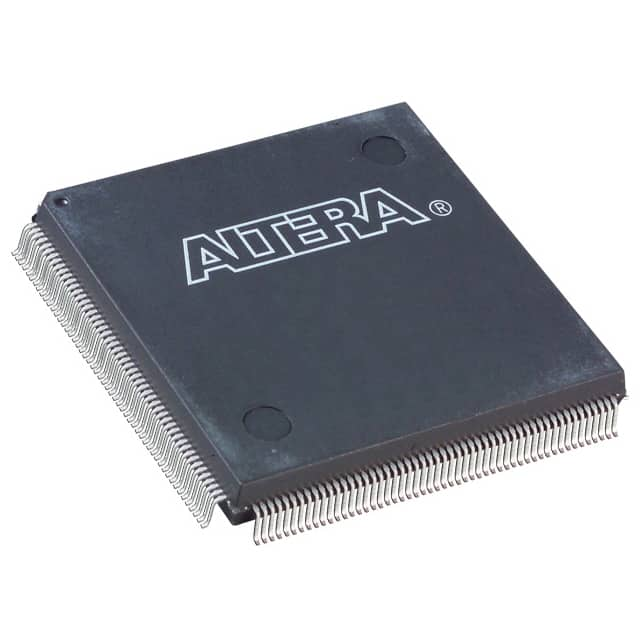EPM7512AEQC208-7
Product Overview
Category
The EPM7512AEQC208-7 belongs to the category of programmable logic devices (PLDs).
Use
This device is primarily used for digital circuit design and implementation. It offers a flexible and customizable solution for various applications.
Characteristics
- Programmable: The EPM7512AEQC208-7 can be programmed to perform specific functions, allowing for versatile use.
- High Integration: This PLD integrates a large number of logic gates and flip-flops, enabling complex circuit designs.
- Reconfigurable: The device can be reprogrammed multiple times, making it suitable for iterative development and prototyping.
- Low Power Consumption: The EPM7512AEQC208-7 is designed to operate efficiently with minimal power consumption.
Package
The EPM7512AEQC208-7 is available in a Quad Flat Pack (QFP) package.
Essence
The essence of this product lies in its ability to provide a flexible and customizable solution for digital circuit design and implementation.
Packaging/Quantity
The EPM7512AEQC208-7 is typically packaged individually and is available in various quantities depending on the manufacturer's specifications.
Specifications
- Model: EPM7512AEQC208-7
- Package Type: QFP
- Pin Count: 208
- Operating Voltage: 3.3V
- Maximum Operating Frequency: 100 MHz
- Programmable Logic Elements: 512
- Flip-Flops: 256
- I/O Pins: 160
Detailed Pin Configuration
The EPM7512AEQC208-7 has a total of 208 pins. The pin configuration is as follows:
(Pin diagram or table illustrating the pin numbers and their corresponding functions)
Functional Features
- High-Speed Operation: The EPM7512AEQC208-7 offers fast operation, making it suitable for time-critical applications.
- Flexible I/O Configuration: The device provides a wide range of configurable input/output pins, allowing for versatile connectivity options.
- Embedded Memory: This PLD includes embedded memory blocks that can be used for data storage or lookup table implementation.
- Built-in Clock Management: The EPM7512AEQC208-7 features built-in clock management circuitry, simplifying timing control in digital designs.
Advantages and Disadvantages
Advantages
- Flexibility: The programmable nature of the EPM7512AEQC208-7 allows for easy customization and adaptation to changing requirements.
- Integration: The device's high integration level reduces the need for additional components, saving space and cost.
- Reusability: The ability to reprogram the PLD multiple times enables its reuse in different projects, reducing overall development costs.
Disadvantages
- Learning Curve: Utilizing the full potential of the EPM7512AEQC208-7 may require a learning curve, especially for beginners in digital circuit design.
- Limited Resources: The device has a finite number of logic elements and I/O pins, which may restrict the complexity of certain designs.
Working Principles
The EPM7512AEQC208-7 operates based on the principles of programmable logic. It consists of an array of logic elements interconnected through configurable routing resources. These logic elements can be programmed to perform specific functions by configuring their interconnections and implementing desired logic equations.
Detailed Application Field Plans
The EPM7512AEQC208-7 finds applications in various fields, including: - Industrial Automation: The device can be used to implement control systems for industrial processes. - Communications: It can be utilized in communication equipment for signal processing and protocol implementation. - Automotive Electronics: The PLD can be employed in automotive systems for functions like engine control and driver assistance. - Consumer Electronics: It finds use in consumer electronic devices for digital signal processing and control applications.
Detailed and Complete Alternative Models
- EPM7512BQC208-7: Similar to the EPM7512AEQC208-7, but with additional features such as higher operating frequency and increased logic elements.
- EPM7516AEQC208-7: A higher-capacity version of the EPM7512AEQC208-7, offering more logic elements and I/O pins.
- EPM7508AEQC208-7: A lower-capacity alternative with fewer logic elements and I/O pins, suitable for less complex designs.
(Note: Provide a comprehensive list of alternative models with their key specifications)
In conclusion, the EPM7512AEQC208-7 is a programmable logic device that offers flexibility, high integration, and reconfigurability. While it has advantages such as flexibility and integration, it also has limitations in terms of learning curve and limited resources. Its working principle revolves around programmable logic, and it finds applications in various fields. Additionally, there are
Senaraikan 10 soalan dan jawapan biasa yang berkaitan dengan aplikasi EPM7512AEQC208-7 dalam penyelesaian teknikal
Sure! Here are 10 common questions and answers related to the application of EPM7512AEQC208-7 in technical solutions:
Question: What is the EPM7512AEQC208-7?
Answer: The EPM7512AEQC208-7 is a specific model of Field Programmable Gate Array (FPGA) manufactured by Intel.Question: What is the purpose of using EPM7512AEQC208-7 in technical solutions?
Answer: The EPM7512AEQC208-7 FPGA can be used to implement complex digital logic circuits, making it suitable for various applications such as signal processing, data encryption, and control systems.Question: What are the key features of EPM7512AEQC208-7?
Answer: Some key features of EPM7512AEQC208-7 include 5120 Logic Elements (LEs), 288 Embedded Memory Blocks (EBMs), and support for various I/O standards.Question: How does EPM7512AEQC208-7 differ from other FPGAs?
Answer: EPM7512AEQC208-7 offers a unique combination of logic elements, memory blocks, and I/O capabilities, making it suitable for specific applications that require a balance between performance and resource utilization.Question: Can EPM7512AEQC208-7 be programmed using industry-standard tools?
Answer: Yes, EPM7512AEQC208-7 can be programmed using popular design software like Intel Quartus Prime, which provides a comprehensive development environment for FPGA designs.Question: What are the power requirements for EPM7512AEQC208-7?
Answer: The power requirements for EPM7512AEQC208-7 depend on the specific implementation and operating conditions. It is recommended to refer to the datasheet and design guidelines provided by Intel for accurate power estimation.Question: Can EPM7512AEQC208-7 be used in safety-critical applications?
Answer: Yes, EPM7512AEQC208-7 can be used in safety-critical applications, provided that proper design practices and verification processes are followed to ensure functional safety requirements are met.Question: Are there any limitations or constraints when using EPM7512AEQC208-7?
Answer: Like any FPGA, EPM7512AEQC208-7 has certain limitations such as limited resources (LEs, memory blocks), maximum operating frequency, and I/O capabilities. These should be considered during the design phase.Question: Can EPM7512AEQC208-7 be reprogrammed multiple times?
Answer: Yes, EPM7512AEQC208-7 can be reprogrammed multiple times, allowing for iterative development and testing of different designs or firmware updates.Question: Where can I find additional technical documentation and support for EPM7512AEQC208-7?
Answer: You can find additional technical documentation, datasheets, application notes, and support resources on the official Intel website or by contacting their customer support team.


